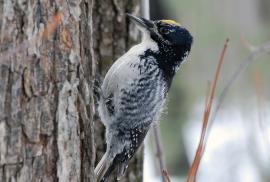Guide to Boreal Birds
Overview
American Three-toed Woodpeckers breed further north than any other woodpecker and occur in dense coniferous forests of subalpine fir and Engelmann spruce and are associated with lodgepole pine and mixed coniferous forests at lower elevations. They seem to prefer areas disturbed by fire, wind, droughts and floods that subsequently result in epidemics of insects such as spruce bark beetle. In the southern and eastern portions of its range, the Three-toed Woodpecker is less numerous than the Black-backed, but its range extends farther south in the Rockies. It is also more sedentary, rarely moving far from its home range. It is unclear if American Three-toed Woodpeckers are migratory, but population build-ups due to insect epidemics may result in their subsequent migrations outside of their typical home ranges. While American Three-toed Woodpeckers may be negatively affected by salvage logging of disturbed forests, timber harvesting practices that mimic fires by making small clearcuts and leaving patches of optimal habitat interspersed may be able to maintain healthy populations.
Description
8 1/2" (22 cm). A robin-sized woodpecker. Similar to Black-backed Woodpecker, but smaller; bill shorter; back barred black and white. Male has yellow crown; female has solid black crown.
Voice
A soft pik, similar to call of Downy Woodpecker.
Nesting
4 white eggs in a tree hole that is beveled on the lower side of the entrance to form a sort of doorstep for the birds.
Habitat
Coniferous forests in the boreal zone, especially where burned, logged, or swampy.
Range/Migration
Resident in Alaska and east across Canada to extreme northern United States and south in West to mountains of Arizona and New Mexico.



